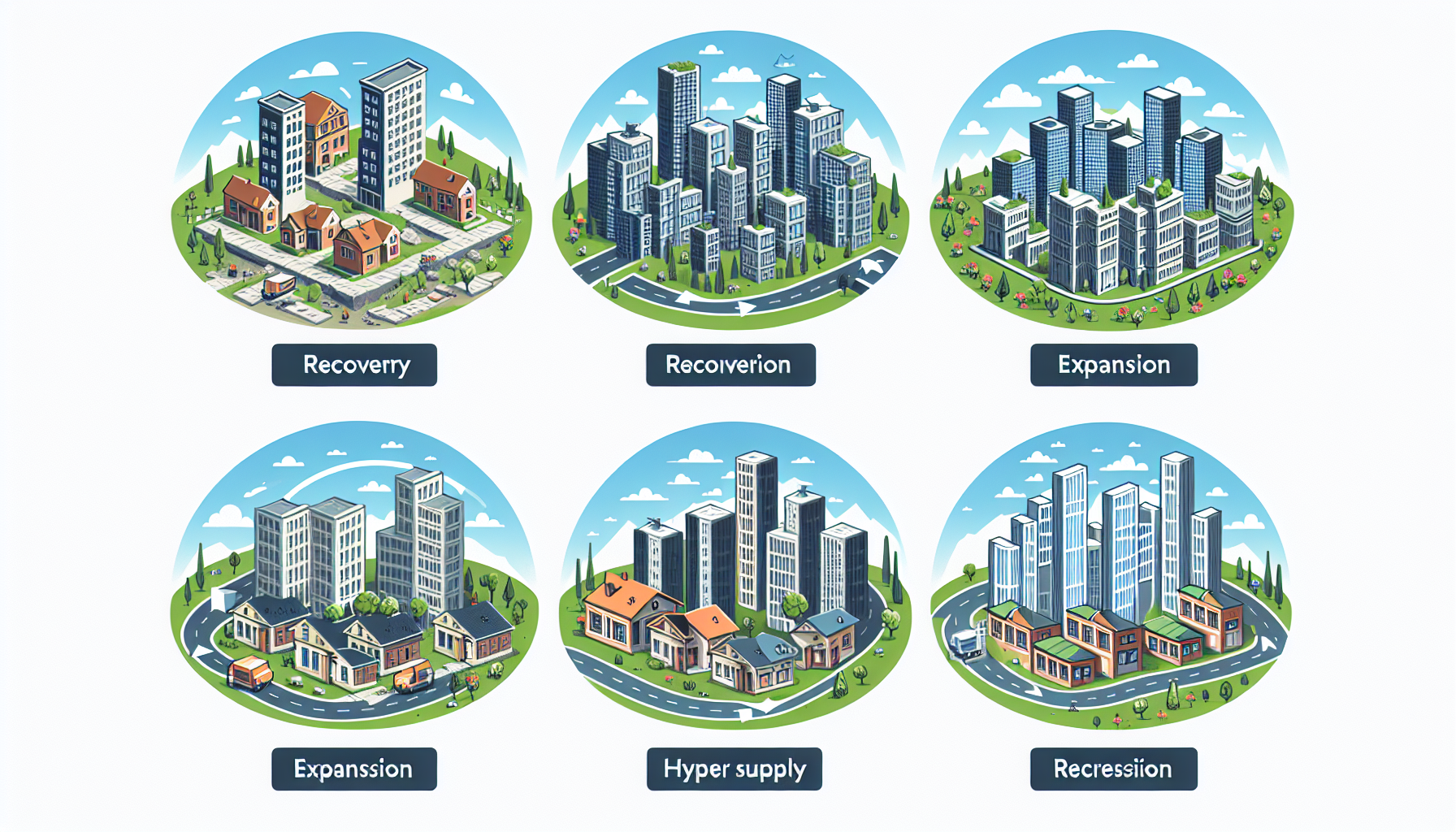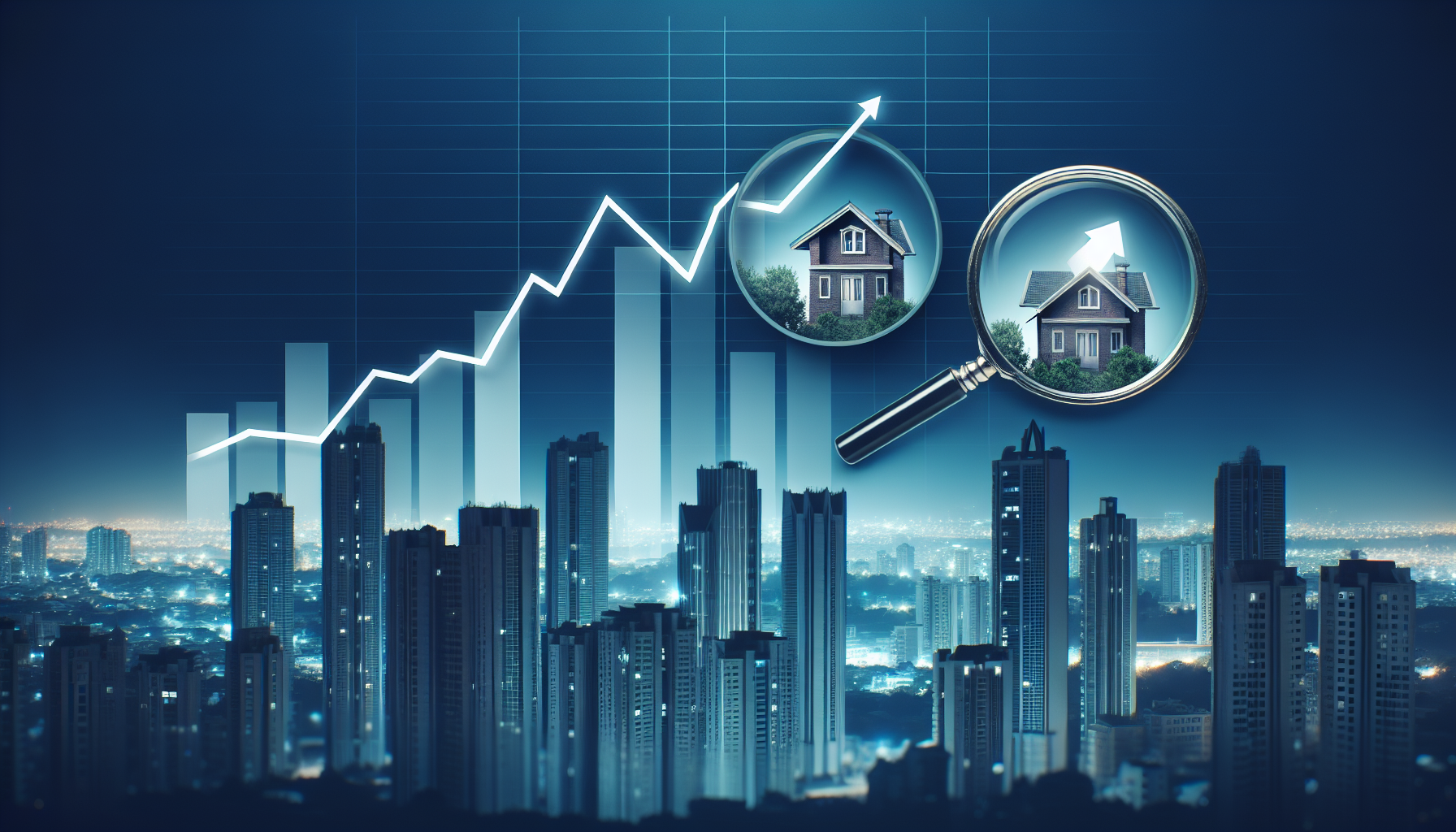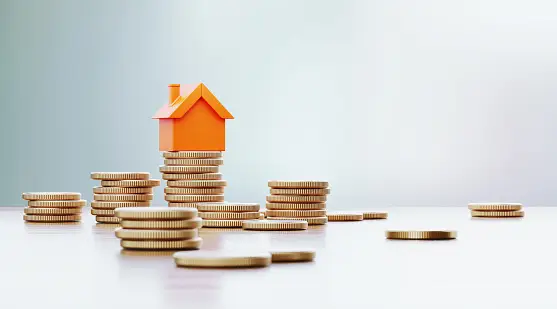How do real estate cycles affect your investment portfolio, and what can you do to leverage them? Each phase of a real estate cycle offers unique challenges and opportunities to investors. In this article, you’ll learn how to identify which phase the market is in and adjust your strategies accordingly, with practical tips that could make a concrete difference to your investment results.
Key Takeaways
Understanding the four key phases of the real estate cycle (Recovery, Expansion, Hyper supply, and Recession) allows investors to make informed decisions and optimize profit potential.
Economic factors like interest rates and GDP growth are significant determinants of the real estate market cycles, and recognizing the signs of each cycle phase enables strategic investment positioning.
Investment strategies must be tailored to align with different phases of the real estate cycle, with specific approaches for buying, holding, liquidating, and risk mitigation to maximize returns and reduce risks.
Decoding the Real Estate Cycle: An Overview

The real estate cycle refers to a sequence of market fluctuations that influence residential real estate property values, demand, and investment prospects. The business cycle is characterized by four key phases:
Recovery
Expansion
Hyper supply
Recession
Understanding the housing market cycle is key for investors, as it enhances their decision-making abilities and optimizes profit potential.
The typical average real estate cycle mirrors market variations, influenced by the effects of distinct phases.
The Essence of the Real Estate Cycle
At the core of the real estate cycle are four distinct stages reflecting shifts in residential real estate markets. These phases are:
Recovery
Expansion
Hyper supply
Recession
Each stage comes with distinct characteristics and economic effects, thereby creating unique market conditions and investment implications.
How the Cycle Moves: From Recovery to Recession
Each phase of the real estate cycle has its defining characteristics. The recovery phase is marked by opportunities to purchase real estate at lower prices due to a lull in demand and stagnant growth.
The expansion phase, on the other hand, is influenced by national economic trends, such as job growth and consumer spending, which can significantly impact this phase. The transition from the recovery phase to the expansion phase in the real estate market cycle signifies a shift in market conditions, typically accompanied by heightened demand and escalating property values.
Timing Your Investments with the Cycle
Timing investments with the real estate cycle can be a game-changer. Investors can maximize returns and minimize risks by tailoring their investment strategies to align with different phases of the real estate cycle. The phases of the real estate cycle impact investment timing through their influence on:
Investment strategy
Holding periods
Exit strategies
Return expectations
Historical data can be utilized to identify market patterns and trends, thus making well-informed investment decisions.
Identifying Signs of Each Phase in the Real Estate Cycle

The ability to identify signs of each phase in the real estate cycle equips investors with a powerful tool. It enables investors to anticipate market shifts and adjust their strategies accordingly. This skill allows investors to know when to buy, hold, or sell properties, maximizing their investment potential.
Spotting the Recovery Phase
During the recovery phase, low demand can be observed through indicators such as low occupancy rates and tepid demand for housing. Spotting this phase is like finding a treasure chest for investors. It offers opportunities to acquire properties at reduced prices and retain them for potential appreciation in the future.
Indicators of the Expansion Phase

The expansion phase is marked by increasing demand, soaring property prices, and a strong economy. Significant job growth during this phase leads to a surge in real estate demand.
Rising property market value indicates:
The market’s complete recovery from the recession phase
High demand
Insufficient supply
Notable increases in rentals and prices
A surge in property demand, fueled by robust job growth, is a significant indicator of the expansion phase of the real estate cycle.
Detecting the Hyper Supply Period
The hyper supply phase of the real estate cycle is marked by an excessive supply of real estate properties and new developments surpassing market demand. This phase results in a rise in vacancy rates and a decline in property prices, signaling a potential market downturn.
Recognizing an Impending Recession
An impending recession in the real estate market is indicated by:
Unsustainable price increases
High inventory
Slower sales
Escalating mortgage rates
Declining consumer confidence
Recognizing these signs allows investors to prepare and adjust their strategies accordingly.
Economic Influences on Real Estate Market Cycles
The real estate market is influenced by a variety of economic factors; it doesn’t operate in isolation. Interest rates and economic growth are two significant factors that significantly impact real estate market cycles.
The Role of Interest Rates
Interest rates significantly influence real estate demand and play a pivotal role in shaping the market. Low-interest rates stimulate demand for property, leading to an increase in prices, whereas high interest rates typically have the converse effect, deterring buyers as a result of the elevated cost of borrowing.
Economic Growth and Its Effects
Economic growth, especially GDP growth, exerts a substantial impact on real estate market trends. When the economy is expanding and jobs are being generated, the real estate market generally sees an upward trajectory.
Strategies for Investing Through Different Market Phases

By employing distinct strategies for each phase of the real estate cycle, investors can maximize returns and mitigate risks. From buying low during the recovery phase to capitalizing on growth during the expansion phase, each phase presents unique opportunities.
Buying Low during the Recovery Phase
The recovery phase offers investors the opportunity to acquire properties at reduced prices and retain them for potential appreciation in the future. The value of a property during this phase is greatly determined by its location.
Expansion Phase: Capitalizing on Growth
During the expansion phase, investors should focus on acquiring new or renovated properties, as these can profit from the significant demand and rent growth that define this phase.
Mitigating Risks in the Hyper Supply Phase
During the hyper supply phase, risk mitigation becomes essential. Strategies such as liquidating real estate property holdings and diversifying investments can aid in this process.
Opportunistic Investing in the Recession Phase
The recession phase can be a time of great opportunity for savvy investors. By acquiring properties at significant discounts, investors can position themselves for high returns in the long term.
Impact of Government Policies on Real Estate Cycles

Government policies and regulations can have significant effects on the real estate cycle, affecting everything from:
interest rates
property taxes
zoning laws
building codes
rent control
mortgage regulations
Understanding these impacts can help investors adapt their strategies and navigate the market effectively.
Real Estate Investment Trusts (REITs) and Market Cycles
Real Estate Investment Trusts, or REITs, offer a unique investment opportunity. These entities provide investors with exposure to different market cycles, diversifying their portfolios and potentially enhancing returns.
Market Trends and Future Predictions
For any investor, comprehending current market trends and anticipating future ones is crucial. It offers insights that can guide investment decisions, helping to maximize profits and minimize risk.
Investors can forecast future trends by:
Evaluating rental values
Conducting real estate market analysis
Analyzing demographics to gain insights into the traits, preferences, and actions of diverse demographic segments, which are essential for forecasting demand in different real estate sectors.
The Role of Real Estate Professionals
Real estate professionals offer invaluable assistance to real estate investors navigating the real estate cycle. From elucidating the four main phases of the cycle to providing insights into market trends and future predictions, these professionals offer expert advice and guidance that can make the difference between a successful investment and a costly mistake.
Summary
In conclusion, understanding the real estate cycle is crucial for any investor. It offers invaluable insights into market trends and future predictions, helping investors make well-informed decisions and optimize their profits. Regardless of whether you are a seasoned investor or a newcomer, a deep understanding of the cycle can open a world of opportunities for profit and growth.
For more strategies on how to crush it in real estate, see our blog post: https://www.quickcommissionadvance.com/blog/top-strategies-to-crush-it-in-real-estate-a-guide-for-ambitious-agents/
Frequently Asked Questions

What are the 4 real estate cycles?
The four real estate cycles are recovery, expansion, hyper supply, and recession. Historically, there has never been a sustained expansion or hyper-supply period without an eventual recession followed by recovery.
What is the real estate business life cycle?
The real estate business life cycle consists of four stages: recovery, expansion, hyper-supply, and recession, and it is important for investors to understand how each phase affects the housing market.
How does the recovery phase impact real estate investment?
The recovery phase in real estate offers investors the opportunity to acquire properties at reduced prices and hold them for potential appreciation in the future, making it a strategic time for investment.
How can investors capitalize on the expansion phase of the real estate cycle?
Investors can capitalize on the expansion phase of the real estate cycle by focusing on acquiring new or renovated properties to benefit from significant demand and rent growth.

Leave a Reply